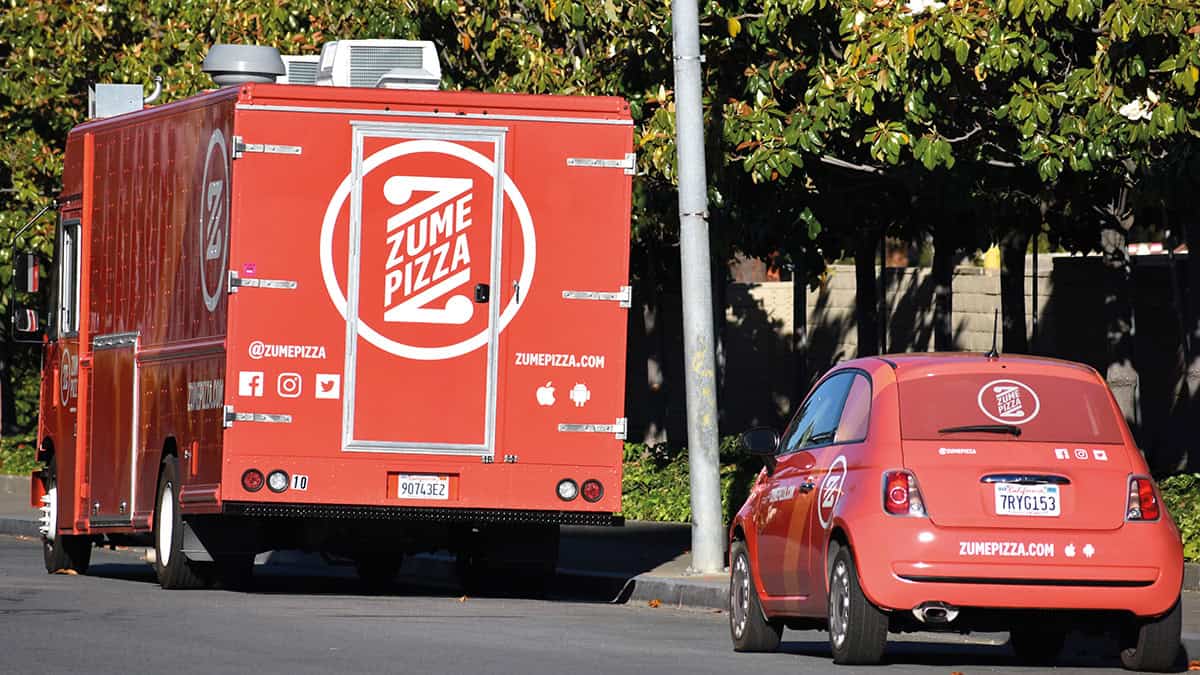Zume was a $500m start-up company that delivered pizzas cooked by robots on trucks. James McKenzie explains what its failure can teach physicists

“The $500 million robot pizza start-up you never heard of has shut down, report says.”
Click-bait headlines don’t always tell the full story and this one is no exception. It appeared last year on the Business Insider website and concerned Zume – a Silicon Valley start-up backed by Japanese firm SoftBank, which once bought chip-licensing firm Arm Holdings. Zume proved to be one of the biggest start-up failures in 2023, burning through nearly half a billion dollars of investment (yes, half a billion dollars) before closing down.
Zume was designed to deliver pizzas to customers in vans, with the food prepared by robots and cooked in GPS-equipped automated ovens. The company was founded in 2015 as Zume Pizza, delivering its first pizzas the year after. But according to Business Insider, which retold a story from The Information, Zume struggled with problems like “stopping melted cheese from sliding off its pizzas while they cooked in moving trucks”.
It’s easy to laugh, but the headline from Business Insider belittled the start-up founders and their story
It’s easy to laugh, but the headline from Business Insider belittled the start-up founders and their story. Unless you’ve set up your own firm, you probably won’t understand the passion, dedication and faith needed to found or join a start-up team. Still, from a journalistic point of view, the headline did the trick in that it encouraged me to delve further into the story. Here’s what I think we can learn from the episode.
A new spin on pizza
On the face of it, Zume is a brilliant and compelling idea. You’re taking the two largest costs of the pizza-delivery business – chefs to cook the food and premises to house the kitchen – and removing them from the equation. Instead, you’re replacing them with delivery vehicles that make the food automatically en-route, potentially even using autonomous vehicles that don’t need human drivers either. What could possibly go wrong?
Zume, which quickly raised $6m in Series A investment funding in 2016, delivered its first pizzas in September of that year. The company secured a patent on cooking during delivery, which included algorithms to predict customer choices. It also planned to work with other firms to provide further robot-prepared food, such as salads and desserts.
By 2018 the concept had captured the imagination of major investors such as SoftBank, which saw the potential for Zume to become the “Amazon of pizza”. The scope was huge: the overall global pizza market was worth $197bn in 2021 and is set to grow to $551bn by 2031, according to market research firm Business Research Insights. So it should be possible to grab a piece of the pie with enough funding and focused, disruptive innovation.
But with customers complaining about the robotic pizzas, the company said in 2018 it was moving in new directions. Instead, it now planned to use artificial intelligence (AI) and its automated production technology for automated food trucks and would form a larger umbrella company – Zume, Inc. It also planned to start licensing its automation technology.

How to persuade a venture capitalist to fund your business
In November 2018 the company raised $375m from SoftBank, now making it worth an eye-popping $2.25bn. It then started focusing on automated production and packaging for other food firms, including buying Pivot – a company that made sustainable, plant-based packaging. By 2020 it was concentrating fully on compostable food packaging and then laid off more than 500 staff, including its entire robotics and delivery truck teams.
Sadly, Zume, Inc was unable to sustain enough sales or bring in enough external funding. Investment cash started running precariously low and in June 2023 the firm was eventually shut down, leaving “joke” headlines about cheese sliding off. How very sad for all involved, but this was only a small part of the issues the company faced.
Inside Zume
Many have speculated where it all went wrong for Zume. To me, the problem seemed to be execution and understanding of the market. The food industry is dominated by lots of dominant established brands, big advertising budgets and huge promotions. When faced with these kinds of challenges, any new business must work out how to compete, break into and disrupt this kind of established market.
Once I looked into what happened at Zume, it wasn’t quite as amazing as I initially thought. To my mind, the logical thing would have been to have all the operations on the truck. But according to a video released by the company in 2016, that’s not what they did. Instead, Zume built an overly complex robot production line in a larger space than a traditional pizza outlet to make the pizzas.
The food was then loaded onto trucks and cooked en-route in a van equipped with 56 automated ovens. Each was timed so that the pizza would be ready shortly before it arrived at the customer’s address. Zume had an app and aimed to cut the delivery time from order to delivery to 22 minutes – which was pretty good. But the app in itself wasn’t a big innovation; after all Domino’s first had one as far back as 2010.
In American start-up culture, failure is not an embarrassment. It’s seen as a learning experience, and looking at the mistakes of history can yield some valuable insights. But then I stumbled upon a really great article by a firm called Legendary Supply Chain that spelled out clearly what happened. Turns out, what really went wrong was Zume’s lack of understanding of the drivers and economics of the pizza-delivery business.
The 3Ps of pizza
Pizzas have a tiny profit margin. But Zume created massive capital costs by developing automation systems, which meant they’d have to sell loads of pizza to make enough return on investment. Worse still, using FedEx-sized trucks to deliver individual pizzas was inherently wasteful and impractical. That’s why you’ll usually see most pizza delivery drivers on bicycles, mopeds or cars, which are a far more cost-effective means of delivery.

Tech phoenix: how electric-vehicle manufacturer Nikola Corporation is rising from the ashes
You could say that Zume re-invented the wheel by re-creating – at great cost – the automation you find in frozen-pizza factories and applying it to a much smaller scale operation. It also seems that the firm didn’t focus enough on the product or what the customers wanted – and instead seemed to solve problems that didn’t exist. In short, the execution was poor and the $400m raised rather went to managers’ heads.
Countless successful companies prove what’s vital are the “3Ps”: product, price and promotion. People buy pizza on an impulse. For me, whenever the idea of a pizza pops into my head, I want something that’s yummy, saves me from cooking and perhaps reminds me of Italian holidays. According to customer feedback, Zume’s pizza was only “okay”. Apart from the cheese occasionally sliding off, it wasn’t any better or worse than anything else.
As far as price was concerned, Zume’s pizzas ought to have been cheaper to make and deliver than rival firms. However, Zume charged a premium price on account of the food being slightly fresher as it was cooked while being delivered. Customers, unfortunately, didn’t buy into this argument sufficiently. I’m not sure what Zume did to promote their products, but with all that money sloshing around, they certainly had more than enough to create a brand.
Zume’s failure won’t be the last attempt to disrupt or break into the pizza-delivery market – and learning from past mistakes could well help
I’m sure Zume’s failure won’t be the last attempt to disrupt or break into the pizza-delivery market – and learning from past mistakes could well help. In fact, I can see why putting sufficiency low-cost automation on a fleet of small vans – coupled with low-cost, central supply depots – might make the economics more favourable. But anyone wanting to revolutionize pizza delivery will have to map out the costs and economics of pizza delivery to get funded and have some good answers to where Zume went wrong.
The odds for start-up success are not good. As I’ve mentioned before, almost 90% of start-ups in the UK survive their first year, but fewer than half make it beyond five years. To get there – whether you’re making pizzas or photodetectors – you’ll need a good plan, a great team, a degree of luck and good timing to compete in the market. But if you do succeed, the rewards are clear.



